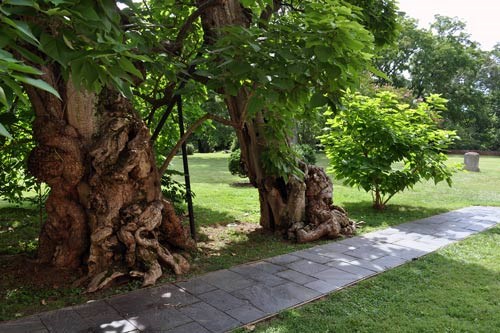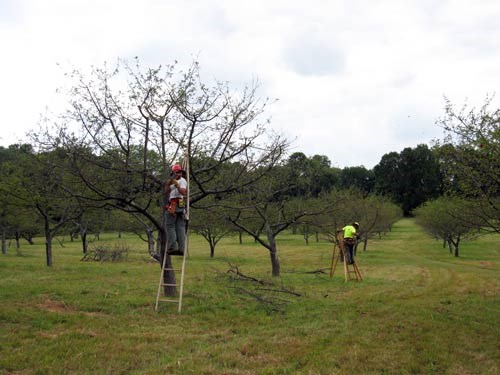Multiple replicates of the same species or the same feature increase the likelihood that some individual specimens will survive a severe disturbance. The presence of replicates skews probability in favor of survivors on the basis of numbers. For biotic features, redundancy also increases the odds of mutations or variants that could increase innate ability to withstand disturbance. Surviving individuals provide the building blocks for restoring a disturbed cultural landscape.

NPS
Understanding the life cycle of different landscape materials, including the average functional life spans of different plant species, offers opportunities to plan for replacement prior to loss. Southern catalpas are relatively short-lived trees, with an average life span of approximately one hundred years in Virginia. Recognizing the impending mortality of the catalpas and their importance to the integrity and character of the landscape prompted the NPS to propagate the trees. There is also a sound economic and social basis to establishing replacements in advance of loss. Planting small replacement trees that are allowed to mature in place makes financial sense, and upon loss of the historic specimen, the visual impact will be mitigated by the existence of the replacement specimen.

National Park Service
At Wick Farm, a repertoire of cultural controls is used in combination, illustrating resilience through redundancy. First, the height of ground cover on the orchard floor is kept shorter than six inches tall by mowing. Voles are discouraged by a lack of shelter around tree trunks. Second, tree guards up to eight inches tall can be wrapped around the base of trunks, providing a physical barrier. Third, vole-resistant root stocks such as ‘‘Novole’’ can be used for the propagation of replacement fruit trees. These are unpalatable to voles. Fourth, the technique of bridge grafting can be used to repair trunk wounds or cavities made by voles. A shoot from the tree canopy, the scion wood, is grafted below and above the wound, reconnecting conductive tissue severed by the vole.
Other control techniques include biological controls, such as providing habitat for predators (e.g., owls and other birds of prey) to keep vole populations in check, and chemical controls, such as chemical repellants applied at the base of tree trunks. The redundancy afforded by these methods allows for year-round protection and recognition that some methods will work better than others in light of different environmental conditions.8
One of the greatest challenges in building redundancy within a cultural landscape is the visual impact of duplicate features. Visual impacts, however, can be reduced by planning and implementing projects with a complete understanding of features’ life cycles and the network of interactions that support or compromise durability. In rehabilitation projects, redundancy by design ensures the presence of duplicates in the event that one or more features are lost or compromised. In preservation maintenance, redundancy involves employing a variety of techniques that provide backups in the event that one or more fails.
8. National Park Service and the University of Massachusetts, Orchard Management Plan for Morristown National Historical Park Wick Farm Orchard (Boston, Mass.: National Park Service, Olmsted Center for Landscape Preservation, 2007).
Last updated: February 24, 2017
